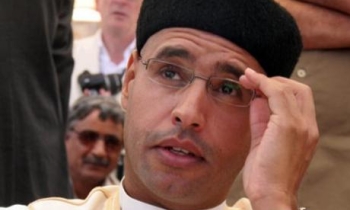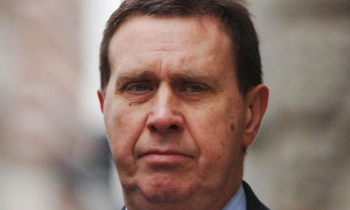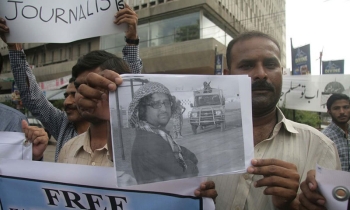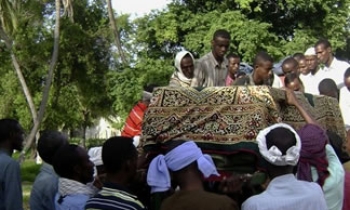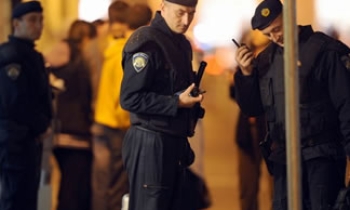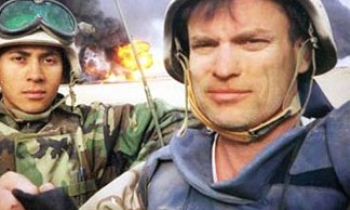Journalists have been making history. In big, fat volumes.
It’s getting harder and harder these days to tell the difference between books of history and books of journalism. Dozens of current or former journalists – like David Halberstam, Anne Applebaum, David Maraniss, Melissa Fay Greene, Richard Kluger, Stanley Karnow, and Robert Caro – have been writing meaty books about events they may not have witnessed, set in times that are well past, and often involving people no longer available for interview. Neither first nor rough nor drafts, these books have the heft of history.
Historians, meanwhile, no longer waiting until the passions have cooled, are incorporating interviews and on-the-spot research into their writing about current or recent events, and more of them are aiming for audiences beyond academia. Oral historians may be best known for collecting the reminiscences of elderly Holocaust survivors and retired cabinet secretaries, but interviewers from Columbia’s Oral History Research Office were out on the streets just days after the reporters were to ask people about their experiences on September 11, 2001.
The boundaries between historians and journalists are crashing. Does it really matter that much? In some ways, perhaps not. "Both are basically telling a story," said Barbie Zelizer, a former reporter who now teaches at the University of Pennsylvania’s Annenberg School for Communication. "And anybody who can should be tackling events that are unsolved or traumatic; it’s not reserved territory. It’s only the historians and journalists who are traumatized if there’s no demarcation."
That demarcation, like so many others, began its long goodbye during the intellectual and social tumult of the 1960s and 1970s. Rejecting as elitist and deficient the traditional emphasis on politics, diplomacy, and the acts of great men, historians focused instead on ordinary and even marginalized people – women, children, peasants, slaves – who have rarely left much of a paper trail in the libraries and archives. Their lives required different research methods to reach and different techniques to narrate.
Weird things began happening to academic conventions of style, method, objectivity, even the historian’s relationship to fact. In a striking reversal, Natalie Zemon Davis’s book followed the movie version. After serving as a consultant on the popular 1982 film The Return of Martin Guerre, a mysterious true-life tale about an abandoned wife and a dramatic imposture in sixteenth-century France, the Princeton professor went back to the archives to reexamine the events with a more analytical eye. She wrote a book with the same title, ruefully acknowledging that sometimes even the most scrupulous historian can’t be any more certain about events and motives than a movie. In his 1991 book Dead Certainties: (Unwarranted Speculations), Simon Schama, then at Harvard, tackled the problem of historical uncertainty with more glee than rue, tickling some colleagues and appalling others with his freewheeling reimaginings – complete with interior monologues and multiple points of view – of a heroic battlefield death in the eighteenth century and a sordid campus murder in the nineteenth.
In the news business, insurgent New Journalists, dismissing traditional reporting as boring, stagnant, and inadequate, were shattering just about every convention there was: the "5 Ws" style, the 750-word article, objectivity, permissible subjects, the use of the exclamation mark, and the old-fashioned dictum that reporters should never be part of the story. The result was long articles about baton twirling and whole books about oranges, and reporters who had been covering the era’s biggest stories, especially the civil rights movement and Vietnam, took those long stories to more permanent homes between hard covers.
A generation’s worth of changes in the way historians and journalists do their jobs has brought them so close together that the differences between their books sometimes seem notional, even anecdotal, to be summed up in a few generalizations – some of them, clearly, gross. Historians tend to have more endnotes, journalists more acknowledgements. Historians are the hedgehogs who know one big thing, journalists the foxes who know many things. Historians locate themselves within and draw upon (or argue with) a community of scholarship; journalists parachute in and take everyone out to lunch. Historians are freer from the pressures of the marketplace; journalists are freer to make the bestseller list. The darkest temptation of the historian is plagiarism; of the journalist, fabrication. The historians are the ones most skittish about using the first-person singular. The journalists are the ones most sunburned on the nose.
But both journalists and historians do see one consequential difference – and both see it as a strength. Nicholas Lemann, the dean of Columbia’s journalism school, is working on a book that won’t include a single interview with any witness or participant in the events he describes. It’s about a battle over voting rights in the Reconstruction South that foreordained the election crisis of 1876, and everybody involved is dead. But besides historical significance, it has what most journalists are trained to look for and, says Lemann, what professional historians are less adept at handling: a "hell of a story."
"Historians try to pose a really interesting problem or contribute to the debate in a field," says Lemann. "But it’s striking how little professional historians know about how to tell a popular story. They think popular’ means picking a good topic.’ They don’t see that storytelling is a learned skill; they don’t see that’s what the nonprofessionals are doing."
That’s also why, Lemann continues, it’s the journalists – the Robert Caros and David McCulloughs – not the academic historians these days who are doing most of the "big-canvas books about big guys doing big things," those sweeping accounts of war or the lives of presidents. Those are news stories.
Diane McWhorter, who spent nearly twenty years researching and writing her Pulitzer prize-winning Carry Me Home: Birmingham, Alabama: The Climactic Battle of the Civil Rights Revolution, did get to interview people, including her own father, whose lives intersected with the lethal 1963 church bombing that lies at the heart of her book. But as a journalist venturing into history, she was, she says, "doubly obsessive; I had to be thorough, to dot all the i’s."
And that wasn’t all. "I came to a point where I thought I understood it all," she says, "but as a journalist bent on telling a story I also felt like I had twice the work. I had to understand the issues, but I also had to figure out how it all fit into some character’s story. I was used to having to figure out what the conflict was."
Yet historians say they’re not immune to the appeal of a good yarn; they just use it differently. The Princeton professor Robert Darnton has noted a surge of academic interest in what he calls "incident analysis," in which the historian starts with the sort of dramatic event any journalist would grab in a minute – a crime, a disaster, a dramatic imposture, or, as Darnton himself once did, the "great cat massacre" by roistering apprentices in eighteenth-century Paris – and "uses the narrative material to argue a case, one where an interpretive problem is at stake," he said in an e-mail. The emphasis is on developing the thesis and sustaining the argument with adequate documentation. Indeed "narrative skill takes second place, if it figures at all."
But the journalist’s professional conditioning to look for the good story, says Darnton, raises its own questions. Journalistic storytelling has a "stylized quality, which can be a disadvantage as well as an advantage. By that I mean a tendency to look for a lead instead of an argument, to hype things, overuse colorful quotes, and exaggerate the importance of personal quirks."
People have always used stories – carefully told or not – to make sense of the world, to explain its big mysteries ("Why are there bad guys?") and its small ones ("Why did he kill her?"). And it’s first and foremost through journalism, especially the busy organism of daily mass journalism, that a society builds the stories it needs most urgently. Journalists and the public together construct stories to order the chaotic buzz of breaking events into a satisfying narrative that reconfirms what’s both important and familiar in the world.
Because of its urgency, daily journalism is more prone to oversimplifying those narratives. Mary Marshall Clark, who as director of Columbia’s Oral History Office organized the 9/11 interview project, saw that temptation in full bloom in much of the journalistic coverage of that day. While the goal of oral-history interviewers is to gather and interpret people’s testimony about their experiences – "to witness the process of witnessing," says Clark – and allow the account to unfold in its own way, many journalists were doing exactly the opposite, fitting the tragic events of the day into "a highly nationalistic frame that emphasized the heroism of the dead."
The oral historians, on the other hand, says Clark, "picked up aspects of the whole experience – the immigrants afraid their alien’ looks might bring violence down on them, or the firefighters who were uncomfortable being portrayed as heroes because they knew they’d made mistakes." People like them were much less likely to make it into the mainstream media coverage at the time because they didn’t advance the narrative that both the public and the press seemed to prefer.
But there’s another problem, less deep perhaps but no less frustrating, with many of the events we call stories that make up the daily budget of the news media. Often they’re not really stories at all, simply piquant episodes, dramatic or telling or cautionary slices of life served up in dizzying succession, and when their "newsworthiness" fades they’re gone from the front page and the public eye. Gary Condit may once have been our constant companion at the breakfast table, but nowadays he never calls and he never writes. Or what seems to be a story proceeding steadily to its appointed end may suddenly veer into a completely new and unexpected direction – remember that "Mission Accomplished" banner? And without a visible ending it’s not "a hell of a story" yet, or even a story – it’s a Power Point presentation.
Which suggests that the distinction most worth exploring between history and daily journalism is neither professional nor temporal but teleological. History can have endings, and most journalism does not. Even though we know in our hearts that history is never really finished, that each new generation reinterprets the past in ways that make sense for its own particular present, narratives of the past can offer what daily journalism almost always cannot: the illusion, at least, of completion. Even though there’s no odometer that clicks over from "now" to "then," the lengthening distance between event and interpreter can bring a certain clarity of vision, as can new evidence, a shifted perspective, or someday, perhaps, even a cooler look at that dusty old archive of oral histories about 9/11. Even though the arc of any historical narrative is arbitrary – stopping with V-J Day makes a vastly different story than stopping with the Berlin airlift – writers of history have a luxury denied the daily journalist: the hindsight to choose an endpoint rather than just waiting for it to come along.
And that promise of tidy resolution may be why, as important as journalism is to the continuing conversation of society, we all ask so much of History, with a capital H. You have only to run a Lexis/Nexis search for "history" within five words of "judge" to see how widespread and irresistible is the idea that there exists some final reckoning, some great arbiter that will coolly render the verdict of the ages, Olympian and infallible, and, no doubt, enshrined within a nice strong binding with gilt lettering on the spine. Even if we don’t like any of the history we’ve got now, we never seem to lose hope in the history of the future.
During the three and a half hours of interviews Bob Woodward conducted with George W. Bush for Plan of Attack, his almost instant book on the invasion of Iraq, the journalist asked the president how history would judge his war. "Bush smiled," Woodward writes. "History,’ he said, shrugging, taking his hands out of his pockets, extending his arms out and suggesting with his body language that it was so far off. We won’t know. We’ll all be dead.’"
He shouldn’t count on it. We all want to be around for that history.

